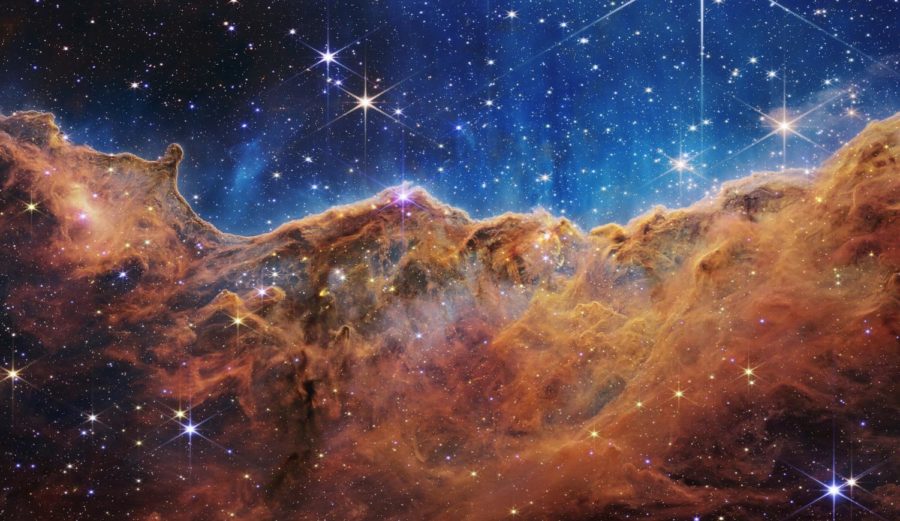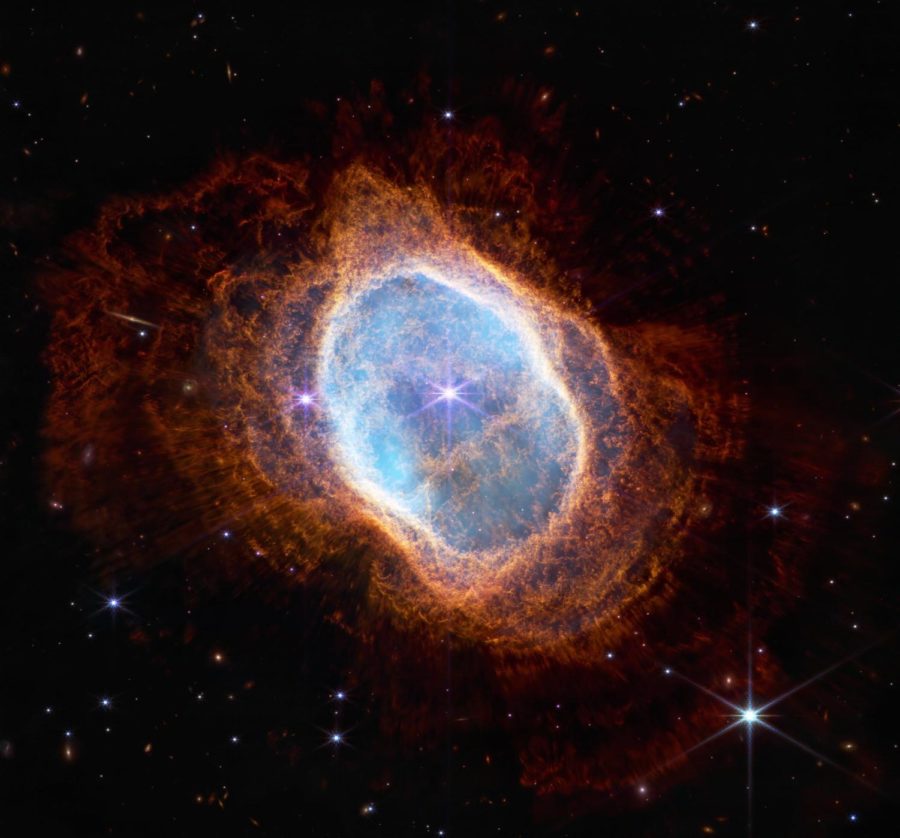Opening Doors in the World of Space Exploration: The James Webb Telescope
NASA’s James Webb Telescope is reaching deeper into space than it was ever thought possible to do.
Image: National Aeronautics and Space Administration (a U.S. federal government agency; https://www.nasa.gov/)European space agency (https://www.esa.int/), Canadian Space Agency (https://www.asc-csa.gc.ca/eng/)Space Telescope Science Institute (https://www.stsci.edu/, science operations center for the Hubble Space Telescope), Public domain, via Wikimedia Commons
Webb captures an image of the Carina Nebula, formally known as the NGC 3324.
On December 25th, 2021, at 7:20 a.m. EST, NASA launched the James Webb Telescope into orbit. The James Webb Telescope, or simply Webb, is the most powerful telescope to date, surpassing the Hubble Space Telescope, which launched in 1990. Construction on Webb began in 2004 and has cost around 10 billion dollars. Since its launch, Webb has impressed scientists and laypeople across the globe.
What is the James Webb Telescope?
The James Webb Telescope is a collaboration of National Aeronautics and Space Administration (NASA), the European Space Agency, and the Canadian Space Agency. Located one and a half million kilometers from Earth, Webb was built to accomplish four main goals: looking at the first stars and galaxies in the early universe, identifying galaxies too difficult to view with the Hubble Telescope, capturing the birth of stars, and further studying planets and planetary systems.
Webb is an infrared telescope. Infrared light is part of the electromagnetic spectrum and is not visible to the human eye. Many distant galaxies and planets from Earth shine in this light. To view this light Webb was equipped with infrared detectors. These detectors absorb photons and convert them into electronic voltages that can be measured by scientists. The detectors are very sensitive, which is needed for how subtle the light captured from these distant galaxies is. Using the detectors the telescope can see through dust clouds in space. With this, Webb allows us to speculate the galaxies and planets that would otherwise go unrecognized. It can look far back into space and time to see some of the earliest formations in the universe.
The creation of the telescope took decades of innovation. The JWST team all work carefully together to keep the Webb telescope operating as the most advanced telescope in the world.
The telescope has a primary mirror made of eighteen folding hexagonal segments made of lightweight beryllium. The overall mirror is 6.5 meters long, making it the largest mirror launched into space. This is the optimal size for the telescope to measure light from distant space. The build of these mirrors lets Webb look deep into the universe and focus properly.
Webb must be kept very cold in order to observe the faint heat signals of infrared light. To accomplish this, Webb was given a sunshield. The sunshield that protects the telescope from heat sources like sunbeams. For this reason, the shield always remains positioned towards the sun, the primary source of heat. Composed of five layers of Kapton coated in aluminum, the shield cools down the telescope to a temperature around -233°C. Kapton is a polyamide film, making it perfect for the shield due to its high heat resistance and ability to remain stable at a range of temperatures.
The microshutters were newly designed for the Webb telescope. These tiny cameras with shutters are devices that allow Webb to focus on many things at once, giving the telescope the ability to capture everything in a cluster of galaxies in one image.
Webb’s accomplishments so far
On July 12th, 2022, NASA released the first images captured by Webb.
“The images you’re going to see today (July 12, 2022) exceed looking back, 13 billion years. That’s the threshold we are crossing,” said Bill Nelson, a NASA Administrator.
One of the many photos taken was of the Southern Ring nebula. The image showcases the colorful, almost foamy-looking gas clouds expelled from this dying star. This nebula is around 2,500 light years away. A light year is a large unit of measurement equal to around 5.88 trillion miles, and equal to the distance that light travels in one year. NASA was able to capture an image of this star in the middle of the Nebula and discovered that this star is surrounded by dust it has been expelling for thousands of years.
Another image released by NASA was of the Carina Nebula, pictured at the top of the article. The image of this “mountain range” looking display explores a gaseous cavity of the nebula where stars are born. This area was impossible to see by telescope before Webb.
Containing over 150 million pixels, Webb’s largest photo at that time was of Stephan’s Quintet. As its name suggests, Stephan’s Quintets is made up of five galaxies. The photo sparkles with millions of stars, and gas that surrounds the galaxies. But what makes this image so interesting is that one of the galaxies is crashing through the cluster in the photo.
Arguably the most important of the images released was Webb’s first deep-field image. A deep field image captures galaxies, and stars that are dim and harder to see, by looking into the space between them. Webb’s first deep field captured the SMACS 0723 cluster of galaxies. This extraordinary display showcased how Webb was accomplishing exactly what it set out to do. The photo doesn’t just capture an image of these galaxies but also what they looked like billions of years ago.
“The speed of light is only so fast. As we’re seeing distant galaxies out in space, we’re seeing them as they looked billions of years ago. These cluster galaxies, the white ones, we’re seeing about the time the sun and the earth formed,” said Jane Rigby, James Webb Telescope operations project scientist.
“This is exciting because it covers infrared wavelengths of light that we have not had access to before,” added Knicole Colón, James Webb Telescope deputy project scientist.
Colón perfectly highlights what was so special about the first “showcase” Webb released. It gave people the first look into a world of space that Webb was beginning to open up.
Since July 12th, 2022, the telescope has continued to impress. Just two days after the first photos came out, NASA published images of Jupiter and one of its largest moons, Europa.
“These wavelengths can only be observed from space, but they have some key spectral signatures telling us what Jupiter’s cloud particles are made of,” said Michael H. Wong, an astronomer at the University of California, Berkeley.
On August 2nd, 2022, the Webb captured yet another beauty: The “Cartwheel Galaxy.” The Cartwheel Galaxy is around 500 million light years from Earth. To put that into perspective, 500 million light years is around 5.88 trillion miles. Photos of this galaxy were captured by the Hubble Telescope many years ago, but the new ones taken by Webb furthered what we’ve already seen, giving us an in-depth view of the star formations within the “Cartwheel” that enhances our understanding of the galaxy.
Jumping forward to September 21st, 2022, Webb takes photos of the furthest planet in our solar system, Neptune. Just like Jupiter, photos of Neptune are not a “new” thing since Hubble has taken many of them in the past, but Webb provides a new perspective to the planet. These images beautifully capture the rings of Neptune and give insight as to what those rings are made out of and how large they are. Additionally, the image looks past Neptune and looks upon the galaxies surrounding it, including half of its fourteen moons.
Webb shows no sign of stopping anytime soon. Just recently on October 19th, 2022, it captured yet another beauty, The Pillars of Creation. The Pillars of Creation is a small section of the Eagle Nebula that produces stars. Hubble took photos of this cosmic landscape back in 1995, but it couldn’t capture nearly as much as Webb was able to now. Webb looked through the dust clouds and viewed the infrared light in the pillars of creation. The image is scattered with baby stars that went completely unnoticed by Hubble.
The JWST team at NASA plans to continue its research using the telescope while building off the research gathered by Hubble. They are possibly working towards answering a question everyone wants to know the answer to: does life exist outside Earth?
“The images you’re going to see today (July 12, 2022) exceed looking back, 13 billion years. That’s the threshold we are crossing,” said Bill Nelson, a NASA Administrator.
Eilidh Ince is a Copy Chief and Social Media Manager for 'The Science Survey.' Eilidh enjoys using journalism as a platform to express her passions, interests,...












